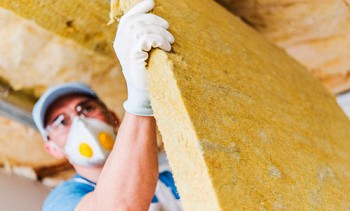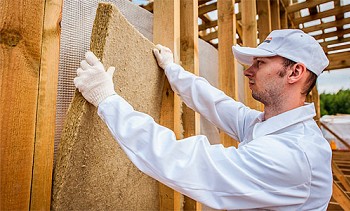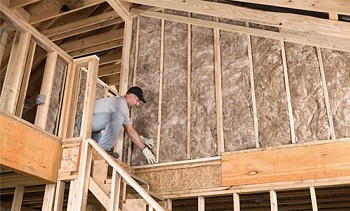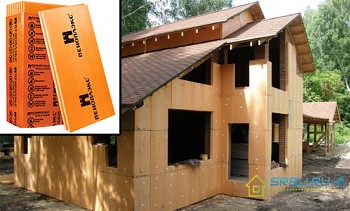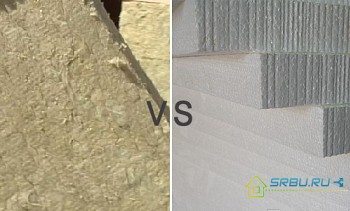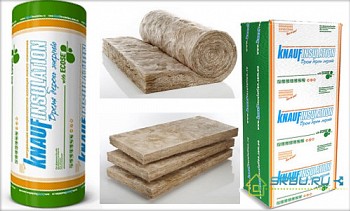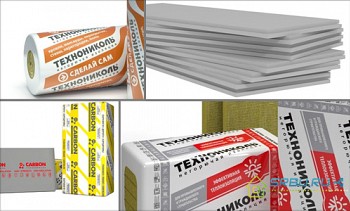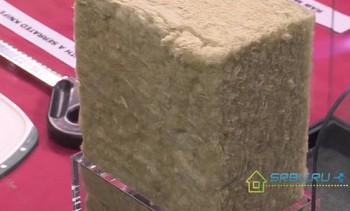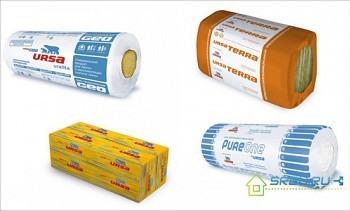Insulation Isover technical specifications and properties
A great many thermal insulation materials are offered to consumers today. More and more of their types enter the construction market. Manufacturers, competing with each other, are trying to improve existing types of insulation, giving them new properties. But there are also such materials that remain unchanged, rightfully occupying leading positions in the ranking. As an example, Isover is a heater, the technical characteristics of which provide excellent results with thermal insulation.
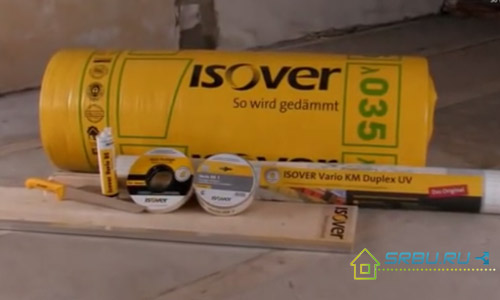
In principle, this material has many advantages and disadvantages of mineral wool - because their properties are very close. It is produced in the form of plates, both rigid and semi-rigid. And it is also sold in the form of rolls and mats that can be used to insulate roofs, ceilings, building facades, ceilings, walls and floors, ventilation pipes. The basis of Izover are glass fibers with a length of 100 to 150 microns and a thickness of 4 to 5 microns. Thanks to these parameters, the insulation has high elasticity, as well as resistance to stress.
Characteristics of insulation Izover
This material is made of fiberglass of the highest quality by TEL technology, which is patented. All this makes Isover one of the best heat insulators, which differs from analogues for the better. We list its useful qualities.
Thermal conductivity
The thermal conductivity coefficient of this insulation has a tiny value - 0.041 watts per meter per Kelvin. Moreover, this value does not change over time in the direction of increase (as is often the case with other heat insulators). Thus, the glass fibers of Izover, which hold the air well, perfectly save heat.
Soundproofing
As for the ability to protect against external noise, here, too, fiberglass materials are on top. This is again due to the fact that there is an air gap between the glass fibers, which successfully delays extraneous sounds. Therefore, silence in the room insulated by Isover will be provided to you. For these purposes, released special varieties of material.
Flammability
All heat-insulating materials with a density of up to 30 kilograms per cubic meter and bearing the name Isover are considered non-combustible. So they are determined by the corresponding GOST 30244-94, which assigns them the abbreviation NG. Therefore, such a heater is quite possible to apply in any houses - the characteristics of Izover of this type allow this. Its use is absolutely safe when insulating both a one-story cottage and a high-rise building.
Materials of a rigid and semi-rigid type, as well as those having a coating of Tyvek film, aluminum foil or fiberglass, are considered to be slightly combustible. According to GOST, they are designated SG. There are restrictions for the use of such insulation, but there are very few of them. So they can be applied almost everywhere. The main thing is to strictly comply with the fire safety regulations of buildings and structures set forth in SNiP 21-01-97.
Vapor permeability
Now let's talk about resistance to moisture. Indeed, it is this parameter that is the “weak link” of many modern heat insulators. They perform their function well only when the air in the room is dry.If it contains moisture, then even fiberglass's ability to retain heat can be impaired. But glass fibers are good in that they quickly give back all the moisture that they absorbed.
And for this we must not forget to leave a gap between the wall and the insulation, not less than 2 centimeters for ventilation. If this is not done, then the insulating qualities of this material will begin to decrease as the moisture is saturated. Unfortunately, this is a flaw in all such materials. The vapor permeability of Isover is in the range 0.50 - 0.55 mg / mhPa. When the insulation is moistened by 1%, a sharp deterioration in thermal insulation occurs up to 10%.
Life time
The most important parameter is the service life of the insulation. Even if it perfectly stores heat, but is able to last a year by force, it is unlikely that anyone will like it. Warming the house is a painstaking task, and doing it every year is not a pleasant business. But, fortunately, these claims do not apply to Izover. By laying walls, floors or ceilings with this material, you can forget about insulation for many years. There are examples of the use of this insulation for more than 50 years without loss of thermal insulation qualities.
And Isover in its composition has water repellents that have water-repellent properties. In addition, bugs and other insects do not settle in this insulation - they do not like such a habitat. Fiberglass insulation is also not available for mold.
Environmental friendliness and harmlessness
Not only the technical characteristics of Isover can flash. Fiberglass materials of this type are absolutely harmless to human health and life. During their operation no harmful substances are emitted. For half a century, Finnish scientists have verified this fact. No danger was found - such a verdict was repeatedly passed by experts of the Institute of Cancer Problems.
Insulation weight
If you compare Izover with other heat insulators by weight, but it will be much easier than the rest. Therefore, in those buildings whose walls are made of not very strong materials or excessive load is unacceptable, the use of Izover will prove to be an excellent way out.
Release form
For the convenience of consumers, this insulation is produced in various forms. These are rolls, plates of various stiffness, mats. The thickness of a single-layer Izover varies from 5 to 10 centimeters, and in a two-layer - the thickness of each layer is 5 centimeters. Plates are usually made no larger than meter per meter, but sometimes there are exceptions.
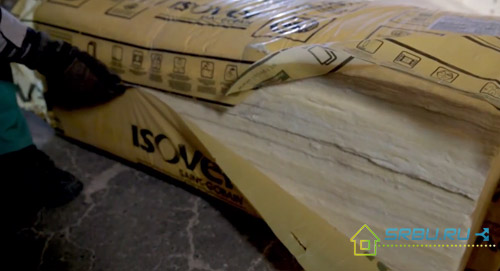
Packaging Izover in the form of compressed plates.
The area of one roll is from 16 to 20 square meters. The standard roll width is 1.2 meters and its length is from 7 to 14 meters.
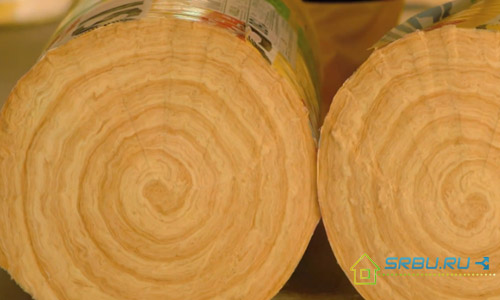
Isover in compressed rolls, when removing the packaging shell independently straightens.
Other characteristics
- The density is about 13 kg / m3.
- The adjacency to the base is not very good and may decrease depending on the insulated object.
- Breathability is 120 * 10-6m3/ m × s × Pa.
In general, many characteristics will depend on the type of material and its purpose, for more details, all characteristics can be found on the official website of Isover.
Where is Isover and its varieties used
Well, as a heater, the characteristics of Isover are quite good. Therefore, it can be used widely - both during the construction of the house, and with exterior and interior decoration. For example, an isover can perfectly insulate the floor under which it blows from the basement. They can cover the walls for insulation, attic or attic, and also protect the walls from the cold wind. By the way, such insulation will be relatively inexpensive.
This material has several varieties. Each of them is designed to perform certain tasks. Next, we list them.
Isover KL34
Isover KL34 is available in the form of plates of 5 or 10 centimeters thick. They are mounted tightly on the frame; in addition, fasteners do not need to be used. Such plates can isolate the ventilated facade and masonry, consisting of several layers.Any planes are suitable for insulation: both vertical and horizontal, and those that are inclined.
Isover KL37
Isover KL37 comes in tightly compressed packages. It also does not require additional fasteners during installation. This material is used to insulate ceilings between floors, walls, roof slopes. In this case, a tight fit of the material to the surface is necessary.
Isover KT37
Isover KT37 is available as compressed rolls. It does not require fasteners, but, like the previous material, should fit well to the insulated plane. It is used for thermal insulation of roofs, attics, floors between floors, walls and partitions indoors.
Isover KT40
Isover KT40 is a two-layer material (each layer has a thickness of 5 centimeters), which is produced in the form of tight rolls. It is used without additional fasteners for insulation of surfaces located horizontally - floors and ceilings. If the cavity for filling with a heater of insufficient depth, then the isover can be divided into two layers.
Isover STYROFOAM 300A
But such a material as Isover STYROFOAM 300A, requires the mandatory use of fasteners. It is available in the form of hard, rough slabs whose surface adheres well to concrete. The composition of this insulation includes extruded polystyrene foam, due to which isolated cells are formed. Due to this, temperature resistance and moisture resistance increase. This heat insulator is suitable for both horizontal and vertical surfaces. They are insulated with external and internal walls, floor and flat roof. Plaster can be applied on top.
Video. How to insulate a plaster facade with Isover materials
Isover VENTITERM
Isover VENTITERM - universal insulation. After all, the technical characteristics of Isover of this type are such that it can be used with or without fasteners. They release it in the form of hard plates treated with a water repellent. The basis of this material is mineral wool, consisting of basalt fibers. They are isolated (on the one hand) by ventilated facades, as well as pipes for ventilation and water supply. It is also used to protect precision instruments from cold.
Isover pitched roof
Isover pitched roof - insulation used for thermal insulation of the roof. Available in the form of plates with a width of 61 centimeters and a thickness of 10 or 5 centimeters. It practically does not absorb moisture, and also absorbs sounds well. High vapor permeability and incombustibility are two more useful properties of this material. It perfectly holds heat, especially if you use its two layers, the upper of which covers the joints of the lower. Important: during installation, the step of the rafter system must be done so that the insulation boards do not fail.
Isover Ventfacade
Isover ventfasad is no different from ordinary Isover. It is available in a two-layer form, due to which it holds heat well. During installation, do not allow the insulation to lag behind the surface.
Isover Soundproof
Isover soundproofing comes in the form of mats and slabs. It is capable of better than other heaters to protect the room from external sounds. It is used to isolate suspended ceilings and interior partitions.
What you should not do when working with Izover and its shortcomings
According to safety precautions, when using fiberglass materials, it is imperative to wear safety glasses, gloves and a gauze bandage. We should not forget about clothes with long sleeves, trousers and socks. That's just in the summer in a stuffy attic to pull all this oh how I do not want to! So many hope for a chance, exposing the torso and cleverly pasting the isover slabs. At first, it seems, nothing, but then you have to regret it. The whole body begins to desperately burn and itch, and even the shower does not help.
When working with this material, try to stand so that bright sunlight shines on the isover. And you will see pillars of fine glass dust in the air. It seems that this sight will be able to discourage the work without protective equipment. But do not be afraid - the laid insulation will not be a danger. To prove this, we give an example: sometimes in the isover, even wasps of a nest are built, and mice gnaw through holes.But it can only be where environmentally friendly.
And in order to know for sure that glass dust will not get into the rooms, lay a film like yutavik between Izover and wall paneling. And then, even if the lining gradually dries up, no glass particles will threaten you. However, if you compare Izover with a domestic splinter of glass wool penetrating through any protection, the comparison will clearly be in favor of the first. And the mice, by the way, are glassy disdain, unlike Izover. So there is reason to think.

